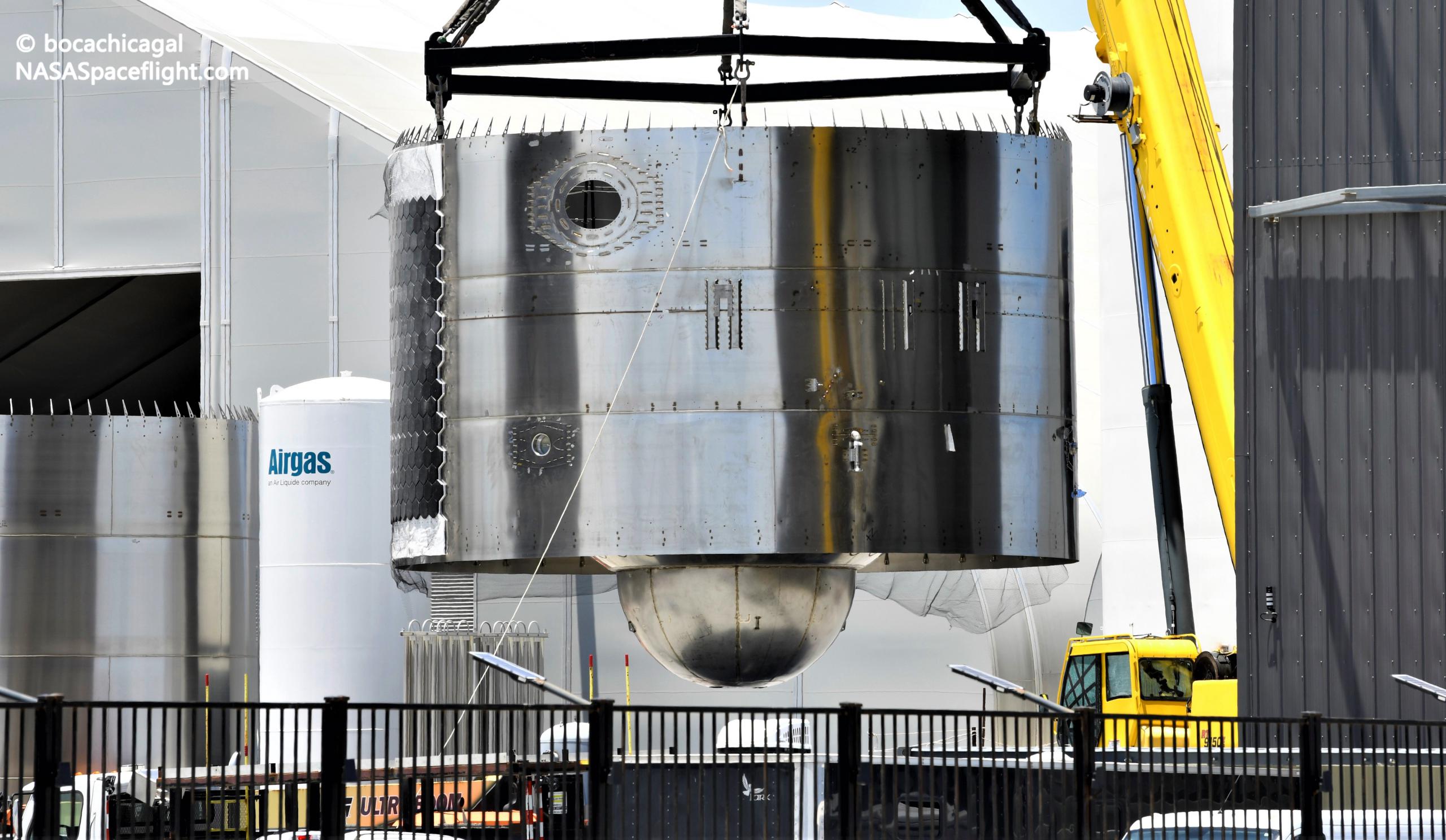
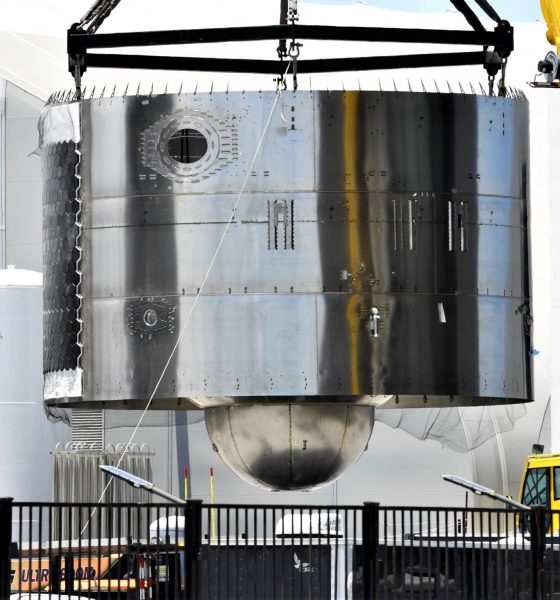
News
SpaceX begins assembling first orbital Starship and Super Heavy booster
SpaceX has begun rapidly assembling the first orbital Starship prototype and the Super Heavy booster set to launch it isn’t far behind.
SpaceX’s Boca Chica, Texas rocket factory seemingly turned a corner in early July as sections of Starship 20 (S20) began to pop up around the site. Though parts labeled Starship “SN20” first appeared as far back as March 2021, the only unequivocal work on SpaceX’s first purportedly orbital-class Starship began in mid-June with the integration of the first engine section with mounts for six – not three – Raptors.
However, in line with SpaceX’s strict focus on maximizing the speed of Starship development and shortening the path to orbit, the company has frequently built Starship hardware before firmly assigning that hardware to any given ship, booster, or tank. In other words, until SpaceX actually begins stacking multiple completed rocket sections, there’s always a degree of uncertainty about the fate of any given ring, dome, or tank barrel. With Starship S20, that process began earlier this month and Super Heavy Booster 4 is likely to follow suit within the next few days – if it hasn’t already.
Since SpaceX unceremoniously rolled Starship prototype SN16 to an empty lot in mid-May, the company didn’t stack a single Starship part until the first week of July – unusual after a frenetic seven months spent building, qualifying, and launching Starships SN8, SN9, SN10, SN11, and SN15 and testing test tanks SN7.2 and BN2.1. Around the same time as Starship SN15 became the first prototype to successfully complete a high-altitude test flight and land in one piece, news broke that SpaceX was striving to perform Starship’s first orbital test flight with Ship 20 (S20) and Booster 3 (B3) as early as July.
Eventually, Booster 3’s orbital launch assignment shifted to Booster 4 as it became clear that the former prototype wasn’t meant to fly, but Starship S20 remained. More likely than not, the almost two-month gap between Starship SN16’s instant retirement and the start of the next flightworthy prototype’s assembly can be explained by the significant changes, upgrades, and undecided design decisions required to jump to S20.
Beyond the need for a thrust structure capable of supporting three sea-level Raptors and three vacuum-optimized engines, Starship S20 would need a full heat shield with thousands of tiles; orbital-class communications and avionics; and the general polished fit and finish required for an orbital launch attempt to have a good shot at producing the data needed for it to be valuable. SpaceX appeared to conclude that those stars were aligned in early July.
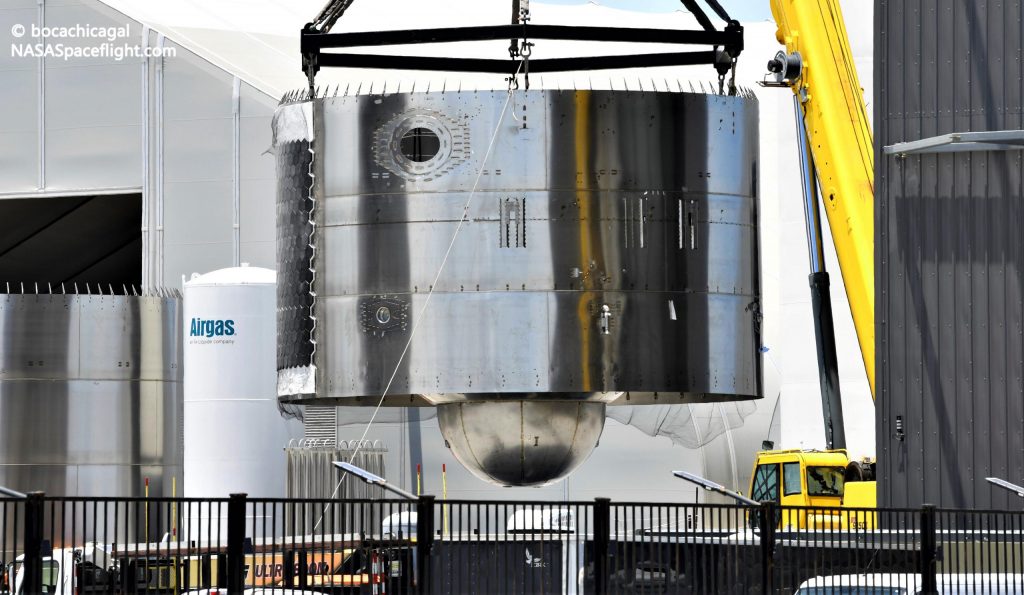
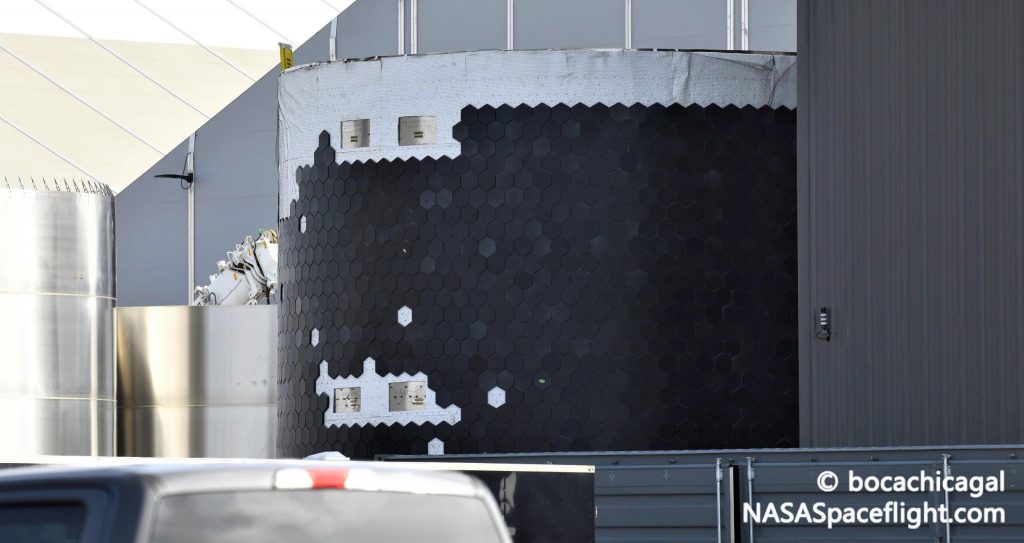
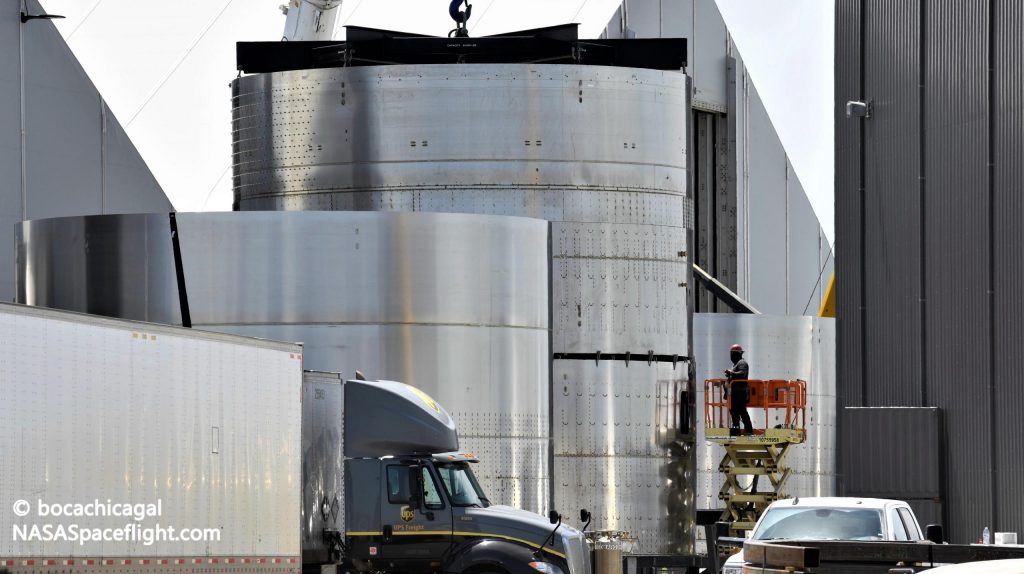
Two weeks after the first stack, Starship S20 is already approximately half-assembled and the last section of the vehicle’s tanks is almost ready for installation. What could be Starship S20’s nosecone is also in the late stages of assembly, though SpaceX has yet to even attempt to fully cover a nose in heat shield tiles and getting that process right could take an attempt or two.
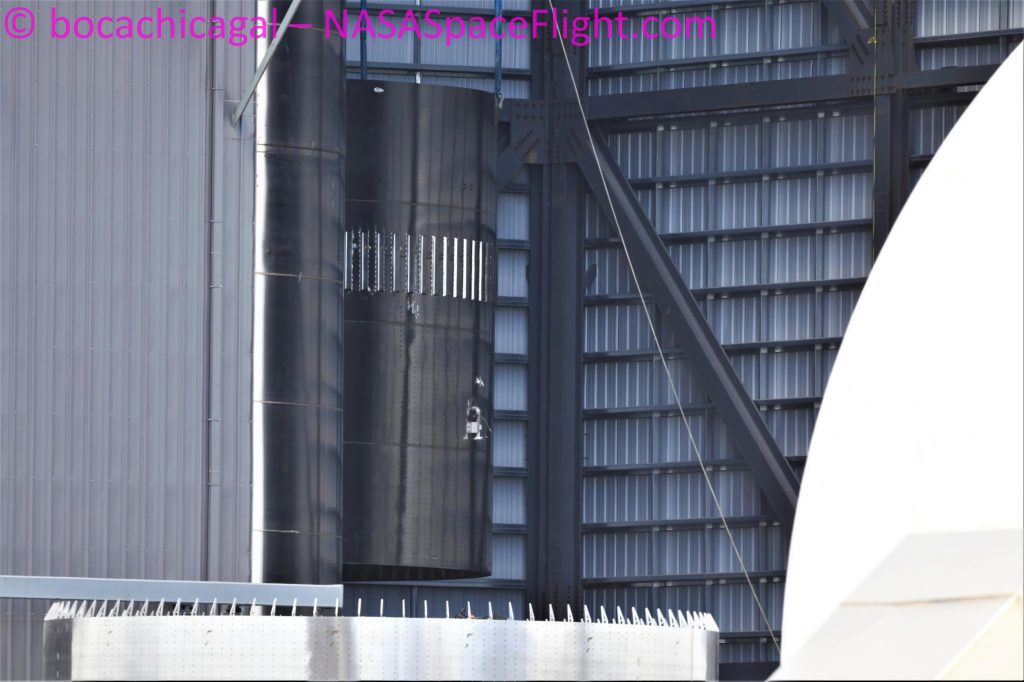
Meanwhile, as evidenced by the booster common dome section hanging in midair in the image above, the assembly of Super Heavy booster 4 (B4) – the same booster tasked with supporting Starship’s first orbital launch attempt – may have begun on July 15th. If the Super Heavy common dome assembly was simply being moved relocated, a separate four-ring section has been staged outside of the high bay to kick off Booster 4 stacking within the next few days.
All told, it’s not inconceivable that both of the first orbital-class Starship and Super Heavy prototypes will be fully assembled and ready for testing – integrated or otherwise – sometime in August.

News
Tesla FSD fleet is nearing 7 billion total miles, including 2.5 billion city miles
As can be seen on Tesla’s official FSD webpage, vehicles equipped with the system have now navigated over 6.99 billion miles.

Tesla’s Full Self-Driving (Supervised) fleet is closing in on almost 7 billion total miles driven, as per data posted by the company on its official FSD webpage.
These figures hint at the massive scale of data fueling Tesla’s rapid FSD improvements, which have been quite notable as of late.
FSD mileage milestones
As can be seen on Tesla’s official FSD webpage, vehicles equipped with the system have now navigated over 6.99 billion miles. Tesla owner and avid FSD tester Whole Mars Catalog also shared a screenshot indicating that from the nearly 7 billion miles traveled by the FSD fleet, more than 2.5 billion miles were driven inside cities.
City miles are particularly valuable for complex urban scenarios like unprotected turns, pedestrian interactions, and traffic lights. This is also the difference-maker for FSD, as only complex solutions, such as Waymo’s self-driving taxis, operate similarly on inner-city streets. And even then, incidents such as the San Francisco blackouts have proven challenging for sensor-rich vehicles like Waymos.
Tesla’s data edge
Tesla has a number of advantages in the autonomous vehicle sector, one of which is the size of its fleet and the number of vehicles training FSD on real-world roads. Tesla’s nearly 7 billion FSD miles then allow the company to roll out updates that make its vehicles behave like they are being driven by experienced drivers, even if they are operating on their own.
So notable are Tesla’s improvements to FSD that NVIDIA Director of Robotics Jim Fan, after experiencing FSD v14, noted that the system is the first AI that passes what he described as a “Physical Turing Test.”
“Despite knowing exactly how robot learning works, I still find it magical watching the steering wheel turn by itself. First it feels surreal, next it becomes routine. Then, like the smartphone, taking it away actively hurts. This is how humanity gets rewired and glued to god-like technologies,” Fan wrote in a post on X.
News
Tesla starts showing how FSD will change lives in Europe
Local officials tested the system on narrow country roads and were impressed by FSD’s smooth, human-like driving, with some calling the service a game-changer for everyday life in areas that are far from urban centers.

Tesla has launched Europe’s first public shuttle service using Full Self-Driving (Supervised) in the rural Eifelkreis Bitburg-Prüm region of Germany, demonstrating how the technology can restore independence and mobility for people who struggle with limited transport options.
Local officials tested the system on narrow country roads and were impressed by FSD’s smooth, human-like driving, with some calling the service a game-changer for everyday life in areas that are far from urban centers.
Officials see real impact on rural residents
Arzfeld Mayor Johannes Kuhl and District Administrator Andreas Kruppert personally tested the Tesla shuttle service. This allowed them to see just how well FSD navigated winding lanes and rural roads confidently. Kruppert said, “Autonomous driving sounds like science fiction to many, but we simply see here that it works totally well in rural regions too.” Kuhl, for his part, also noted that FSD “feels like a very experienced driver.”
The pilot complements the area’s “Citizen Bus” program, which provides on-demand rides for elderly residents who can no longer drive themselves. Tesla Europe shared a video of a demonstration of the service, highlighting how FSD gives people their freedom back, even in places where public transport is not as prevalent.
What the Ministry for Economic Affairs and Transport says
Rhineland-Palatinate’s Minister Daniela Schmitt supported the project, praising the collaboration that made this “first of its kind in Europe” possible. As per the ministry, the rural rollout for the service shows FSD’s potential beyond major cities, and it delivers tangible benefits like grocery runs, doctor visits, and social connections for isolated residents.
“Reliable and flexible mobility is especially vital in rural areas. With the launch of a shuttle service using self-driving vehicles (FSD supervised) by Tesla in the Eifelkreis Bitburg-Prüm, an innovative pilot project is now getting underway that complements local community bus services. It is the first project of its kind in Europe.
“The result is a real gain for rural mobility: greater accessibility, more flexibility and tangible benefits for everyday life. A strong signal for innovation, cooperation and future-oriented mobility beyond urban centers,” the ministry wrote in a LinkedIn post.
News
Tesla China quietly posts Robotaxi-related job listing
Tesla China is currently seeking a Low Voltage Electrical Engineer to work on circuit board design for the company’s autonomous vehicles.

Tesla has posted a new job listing in Shanghai explicitly tied to its Robotaxi program, fueling speculation that the company is preparing to launch its dedicated autonomous ride-hailing service in China.
As noted in the listing, Tesla China is currently seeking a Low Voltage Electrical Engineer to work on circuit board design for the company’s autonomous vehicles.
Robotaxi-specific role
The listing, which was shared on social media platform X by industry watcher @tslaming, suggested that Tesla China is looking to fill the role urgently. The job listing itself specifically mentions that the person hired for the role will be working on the Low Voltage Hardware team, which would design the circuit boards that would serve as the nervous system of the Robotaxi.
Key tasks for the role, as indicated in the job listing, include collaboration with PCB layout, firmware, mechanical, program management, and validation teams, among other responsibilities. The role is based in Shanghai.
China Robotaxi launch
China represents a massive potential market for robotaxis, with its dense urban centers and supportive policies in select cities. Tesla has limited permission to roll out FSD in the country, though despite this, its vehicles have been hailed as among the best in the market when it comes to autonomous features. So far, at least, it appears that China supports Tesla’s FSD and Robotaxi rollout.
This was hinted at in November, when Tesla brought the Cybercab to the 8th China International Import Expo (CIIE) in Shanghai, marking the first time that the autonomous two-seater was brought to the Asia-Pacific region. The vehicle, despite not having a release date in China, received a significant amount of interest among the event’s attendees.








